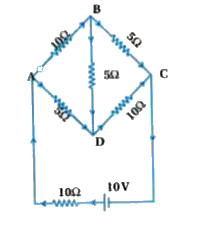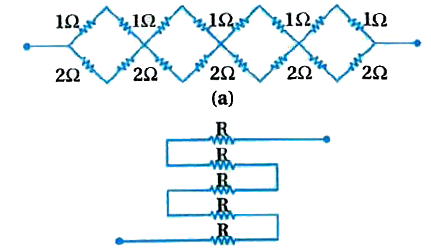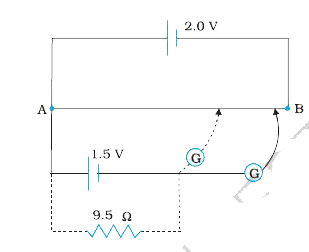Complete Solutions to SECTION [B] (NUMERICAL FROM TEXTUAL EXERCISE) of chapter CURRENT ELECTRICITY of Class 12 book with complete answers and questions
| Class 12 | PHYSICS |
| Chapter | CURRENT ELECTRICITY |
| KUMAR PRAKASHAN | SECTION [B] (NUMERICAL FROM TEXTUAL EXERCISE) |
| Number Of Questions | 35 |
| Academic Year | 2023-24 |
The storage battery of a car has an emf of 12 V. If the internal resistance of the battery is 0.4 `Omega` , what is the maximum current that can be drawn from the battery ?

View SolutionA bettery of emf 10 V and internal resistacne `3 Omega` is connected to a resistor. If the current in the circuit is `0.5A,` what is the resistance of the resistor ? What is the terminal voltage of the bettery when the circuit is closed ?
View SolutionThree resistors `1 Omega, 2 Omega and 4 Omega` are combined in series. What Is the total resistance of the combination ?
View Solution(a) Three resistor `1Omega ,2Omega, and 3Omega` are combined in series. What is the total resistance of the ombination ?
(b) If the combination is connected to a battery of emf 12 V and negligible internal resistance, obtain the potential drop across each resistor.
View SolutionThree resistor 2 `Omega , 4 Omega and 6 Omega` are combined In parallel. What is the total resistance of the combination ?
View Solution(a) Three resistors `2 Omega 4 Omega and 5 Omega` are combined in parallel. What is the total resistance of the combination ?
(b) If the combination is connected to a bettery of emf 20 V and neglibible internal resistance, determine the current through each resistor, and the total current drawn from the battery.
View SolutionAt room temperature `(28.0^(@) C) ` the resistance of a heating element is `100 Omega `. What ic. the temperature of the element if the resistance is found to be 117`Omega`, given that the temperature coefficient of the material of the resistor is `1.70 xx 10^(-4)""^(@) C^(-1)` .
View SolutionA negligibly small current is passed through a wire of length 20 m and uniform cross-section `6.0 xx 10^(7) m^(2)`, and its resistance is measured to be 10.0 `Omega` . What is the resistivity of the material at the temperature of the experiment ?
View SolutionA silver wire has a resistance of 2.1 `Omega` at `27.5^(@)` C and a resistance of 2.8 `Omega` at `100^(@) C `. Determine the temperature coefficient of resistivity of silver.
View SolutionAn electric toaster uses nichrome for its heating element. When a negllgibly small current pases through it, its resistance at room temperature `(27.0^(@)C)` is found to be `75.3 Omega.` When the toaster is connected to a 230 V supply, the current settles, after a few seconds, to a steady value of `2.68A.` What is the steady temperature of the nichrome element ? The temperature coefficient of resistance of nichrome averaged over the temperature range involved is `1.70 xx 10 ^(-4)"" ^(@)C ^(-1).`
View SolutionDetermine the current in each branch of the given network.

View SolutionIn a meter bridge as shown in figure, the balance point is found to be at 39.5 cm from the end A, when the Y resistor is of 12.5`Omega`. Determlne the resistance of X. Why are the connections between resistors in a Wheatstone or meter bridge made of thick copper strips ?
View SolutionWhat happens if the galvanometer and cell are interchanged at the balance point of the bridge ? Would the galvanometer show any current ?

View SolutionWhat happens if the galvanometer and cell are interchanged at the balance point of the bridge ? Would the galvanometer show any current ?

View SolutionA storage battery of emf 8.0 V and internal resistance 0.5 `Omega` is being charged by a 120 V de supply using a series resistor of 15.5 `Omega` . What is the terminal voltage of the battery during charging ?
View SolutionIn a potentiometer arrangement, a cell of emf 1.25 V gives a balance point at 30.0 cm length the wire. If the cell is replaced by another and the balance point shifts to 60.0 cm, what the emf of the second cell ?
View SolutionThe number density of free electrons in a copper conductor estimated is `8.5 xx 10^(28) m^(-3)`. How long does an electron take to drift from one end of a wire 3.0 m long to its other end ? The area of cross-section of the wire is 2.0` xx 10^(-6) m^(2)` and it is carrying current of 3.0 A.
View SolutionThe earth's surface has a negative surface charge density of `10^(-9)C m ^(-2).` The potential difference of 400 kV between the top of the atmosphere and the surface results (due to the low conductivity of the lower atmosphere) in a current of only 1800 A over the entire globe. If there were no mechanism of sustaining atmospheric electric field, how much time (roughly) would be required to neutralise the earth's surface? (This never happens in practice because there is a mechanism to replenish electric charges. namely tghe coontainual thunderstorms and lighting in different parts of the globe). (Radius of earth `=6.37 xx 10 ^(6) m.)`
View Solution(a) Six lead-acid type of secondary cells each of emf `2.0 V` and internal resistacne `0.015Omega` are joined in series to provide a supply to a resistance of `8.5 Omega.` What are the current drawn from the suply and its terminal voltage ?
(b) A secondary cell after long use has an emf of `1.9 V ` and a large internal resistance of `380 Omega.` What maximum current can be drawn from the cell? Could the cell drive tghe starting motor of a car ?
View SolutionTwo wires of equal length, one of aluminium and the other of copper have the same resistance. Which of the two wires is lighter ? Hence explain why aluminium wires are preferred for overhead power cables. `(rho_(Al) = 2.63 xx 10^(-8) Omega m , rho_(Cu) = 1.72 xx 10^(-8) Omega` m, Relative density of Al = 2.7 , of Cu = 8.9 )
View SolutionWhat conclusion can you draw from the follwing observation on a resistor made of alloy manganin ?

View SolutionA steady current flows in a metallic conductor of non-uniform cross-section. Which of these quantities is constant along the conductor: current, current density, electric field, drift speed?
View SolutionIs Ohm's law universally applicable for all conducting elements ? If not, give examples of elements which do not obey Ohm's law.
View SolutionA low voltage supply from which one needs high currents must have very low internal resistance. Why ?
View SolutionA high tension (HT) supply of, say, 6 kV must have a very large internal resistance.Why?
View SolutionChoose the correct alternative:
(a) Alloys of metals usually have (greater/less) resistivity than that of their constituent metals.
(b) Alloys usually have much (lower/higher) temperature coefficients of resistance than pure metals.
(c ) The resisitivity of the alloy manganin is nearly independent of/increases rapidly with increase of temperature.
(d) The resistivity of a typical insulator (e.g., amber) is greater than that of a metal by a factor of the order of `(10 ^(22) //10 ^(23)).`
View SolutionChoose the correct alternative:
(a) Alloys of metals usually have (greater/less) resistivity than that of their constituent metals.
(b) Alloys usually have much (lower/higher) temperature coefficients of resistance than pure metals.
(c ) The resisitivity of the alloy manganin is nearly independent of/increases rapidly with increase of temperature.
(d) The resistivity of a typical insulator (e.g., amber) is greater than that of a metal by a factor of the order of `(10 ^(22) //10 ^(23)).`
View SolutionChoose the correct alternative:
(a) Alloys of metals usually have (greater/less) resistivity than that of their constituent metals.
(b) Alloys usually have much (lower/higher) temperature coefficients of resistance than pure metals.
(c ) The resisitivity of the alloy manganin is nearly independent of/increases rapidly with increase of temperature.
(d) The resistivity of a typical insulator (e.g., amber) is greater than that of a metal by a factor of the order of `(10 ^(22) //10 ^(23)).`
View SolutionChoose the correct alternative:
(a) Alloys of metals usually have (greater/less) resistivity than that of their constituent metals.
(b) Alloys usually have much (lower/higher) temperature coefficients of resistance than pure metals.
(c ) The resisitivity of the alloy manganin is nearly independent of/increases rapidly with increase of temperature.
(d) The resistivity of a typical insulator (e.g., amber) is greater than that of a metal by a factor of the order of `(10 ^(22) //10 ^(23)).`
View Solution(a) Given n resistores each of resistance R. how will you combine them to get the (i) maximum (ii) minimum effective resistance?
(b) Given the resistances of `1 Omega, 2 Omega, 3 Omega.` how will be combine them to get an equivalent resistance of `(i) (11//3) Omega (ii) (11//5) Omega, (iii) 6 Omega, (iv) (6//11) Omega` ?
(c ) Determine the equivalent resistance of networks shown in

View Solution(a) Given n resistores each of resistance R. how will you combine them to get the (i) maximum (ii) minimum effective resistance?
(b) Given the resistances of `1 Omega, 2 Omega, 3 Omega.` how will be combine them to get an equivalent resistance of `(i) (11//3) Omega (ii) (11//5) Omega, (iii) 6 Omega, (iv) (6//11) Omega` ?
(c ) Determine the equivalent resistance of networks shown in

View SolutionDetermine the equivalent resistance of networks shown in figure.

View SolutionDetermine the furrent drawn from a 12 V suly with internal resistacne `0.5Omega ` by the infinite network shown in Each rsistor has `1Omega` resistance.

View SolutionFigure shows a potentiometer with a cell of 2.0 V and internal resistance 0.40 `Omega` maintaining a potential drop across the resistor wire AB. A standard cell which maintains a constant emfof 1.02 V (for very moderate currents upto a few mA) gives a balance point at 67.3 cmlength of the wire. To ensure very low currents drawn from the standard cell, a very high resistance of 600 `k Omega` is put in series with it, which is shorted close to the balance point. The standard cell is then replaced bya cell of unknown emfe and the balance point found similarly, turns out to be at 82.3 cm length of the wire.

(a) What is the value `epsilon` ?
(b) What purpose does the high resistance of 600 `K Omega` have ?
(c) Is the balance point affected by this high resistance ?
(d) Would the method work in the above situation if the driver cell of the potentiometer had an emf of 1.0V instead of 2.0 V ?
(e) Would the circuit work well for determining an extremely small emf, say of the order of a few mV (such as the typical emf of a thermocouple) ? If not, how will you modify the circuit ?
(f) Can we use above circuit to measure very small emf of the order of mV. (For example, emf obtained in thermocouple) ? If not, then what change would you make ?
View Solutionshow a `2.0V` potentiometer used for the determination of internal resistance of a `1.5V` cell. The balance point of the cell in open circuit is `76.3` cm. When a resistor of `9.5Omega` is used in the external circuit of the cell, the balance point shifts to `64.8 cm` length of the potentiometer wire. Determine the internal resistance of the cell.

View Solution
SECTION [B] (NUMERICAL FROM TEXTUAL EXERCISE) questions and complete solutions for chapter CURRENT ELECTRICITY of KUMAR PRAKASHAN KENDRA PHYSICS (GUJRATI ENGLISH) of Class 12
All Exercises from KUMAR PRAKASHAN Class 12 PHYSICS CURRENT ELECTRICITY
- SECTION C (LONG ANSWER TYPE QUESTIONS )
- SECTION C (MULTIPLE CHOICE QUESTIONS (MORE THAN ONE OPTIONS))
- SECTION C (SHORT ANSWER TYPE QUESTIONS )
- SECTION C (VERY SHORT ANSWER TYPE QUESTIONS)
- SECTION C NCERT EXEMPLAR SOLUTION (MULTIPLE CHOICE QUESTIONS (MCQs))
- SECTION [A] TRY YOURSELF
- SECTION [A] QUESTIONS - ANSWERS (INTRODUCTION )
- SECTION [B] (NUMERICAL FROM .DARPAN. BASED ON TEXTBOOK)
- SECTION [B] (NUMERICAL FROM TEXTUAL EXERCISE)
- SECTION [B] (NUMERICAL)
- SECTION [B] NUMERICALS (NUMERICAL FROM TEXTUAL ILLUSTRATIONS)
- SECTION [D] MULTIPLE CHOICE QUESTIONS (MCQs) (MCQs ASKED IN AIIMS)
- SECTION [D] MULTIPLE CHOICE QUESTIONS (MCQs) (MCQs ASKED IN BOARD EXAM AND GUJCET)
- SECTION [D] MULTIPLE CHOICE QUESTIONS (MCQs) (MCQs ASKED IN CBSE-PMT, AIPMT, NEET)
- SECTION [D] MULTIPLE CHOICE QUESTIONS (MCQs) (MCQs ASKED IN COMPETITIVE EXAMS)
- SECTION [D] MULTIPLE CHOICE QUESTIONS (MCQs) (MCQs FROM .DARPAN. BASED ON TEXTBOOK)